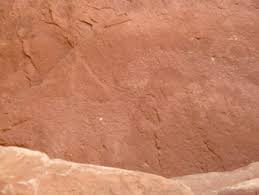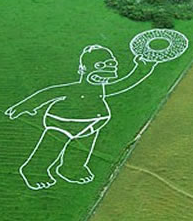The Kachina Bridge Dinosaur Carving Has Been Authenticated and is NO FRAUD!Unlike Darwinist liars who would rather deceive you in the name of science.
This article can be read at the below link.
http://evidenceweb.net/pdfs/kachina-bridge.pdf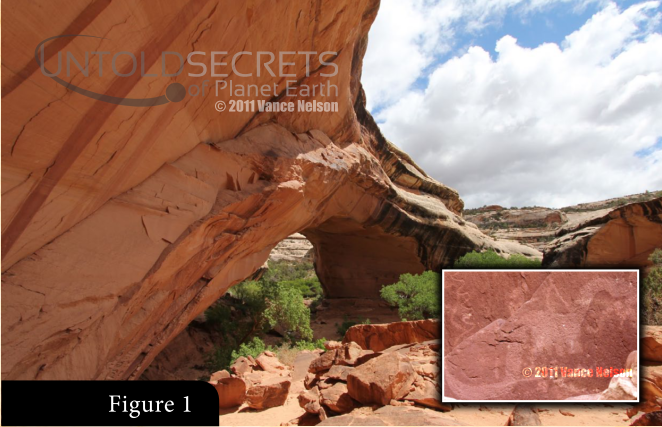
An article entitled, “‘Dinosaur’ petroglyphs at Kachina Bridge site, Natural Bridges National Monument, southeastern Utah: not dinosaurs aſter all” was presented on the Palaeontologia Electronica website in March of 2011. The authors, Phil Senter and Sally Cole, claim that “because mainstream science has produced no alternate explanation for Dinosaur, it has become an important weapon in the arsenal of the anti-evolution movement.” It is interesting that Phil Senter mentions the fact that the main petroglyph in question looks like a dinosaur. Senter says that “Dinosaur, which I’ve nicknamed Sinclair because it looks like the Sinclair Gas logo, really does look like a dino when seen with the naked eye.”
It is clear that the authors set out to refute the petroglyph as evidence, usable by creationists, at any cost. They claim, “until our study, this was the best dinosaur petroglyph — that is, the hardest to argue about, because it looked so much like a dinosaur that there was no way to interpret it as anything else...The ‘best’ dinosaur is now extinct.”
In order to respond to the most important issues raised by the Senter/Cole paper, myself and a colleague revisited the site on May 20, 2011 to make a face-to-face examination and photographic record which demonstrates, contrary to the Senter/Cole assertions, that the entire petroglyph is a unified piece of ancient artwork created entirely by intelligent people using a tool to peck away the desert varnish.
Though Senter and Cole make remarks about numerous items pertaining to the creation vs. evolution controversy, I will be remarking specifically about the sauropod petroglyph under Kachina Bridge within Natural Bridges National Monument (Fig. 1). I have visited this area on a number of occasions to study this petroglyph both prior to and aſter Senter and Cole published their claims.
I. Proper Close-up Inspection had Not Previously Been Done:Quoting from their own writing: “Dinosaur 1 has received considerable attention from young-earth creationists but close inspection and thorough description of it has not occurred before now. This lack of research is understandable, because it is approximately 2m above the head of the average observer on a nearly vertical surface, surrounded by rough and extremely steep terrain that discourages the carrying of a ladder, about an hour by foot from the nearest road.”
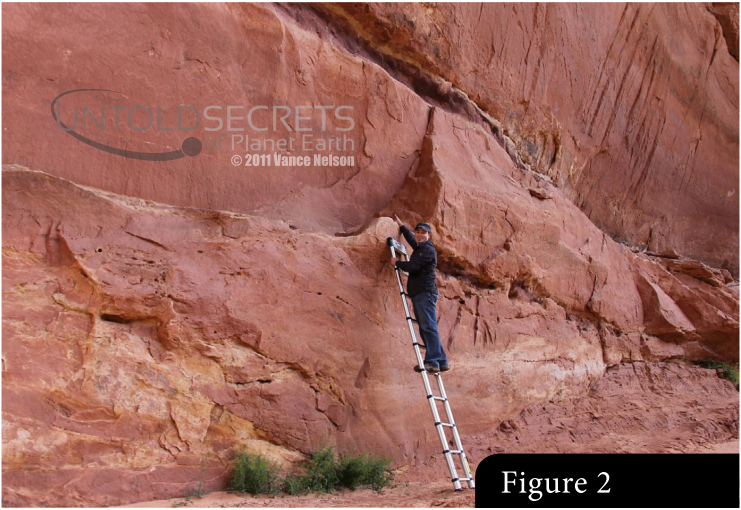
Comments: They suggest that no one has done a proper close-up examination of this petroglyph. This is simply incorrect. I personally know several researchers that have been up on the platform, have done close-up examination, have done measurements of the petroglyph, have taken photographs and done tracings of the image dating back to at least 1997. The fact is many creation researchers have been on the ledge many times doing close-up examinations. Why couldn’t Senter and Cole manage to organize such a close-up examination?
II. The Senter/Cole Method of investigation:Quoting from their own writing: “...the four alleged dinosaur depictions were examined with the naked eye and with the aid of binoculars and telephoto lenses.”
Comments: They used binoculars and telephoto lens for their alleged close-up examination. With all due respect, both of these devices are by definition for long-distance viewing. Therefore, by definition, they never really did any close-up examination. There is really no excuse for not bringing the proper equipment. A ladder is essential to properly analyze the sauropod petroglyph. On May 20, 2011 myself and a research colleague made our way to the site with the proper investigative equipment including a ladder (Fig. 2).
It took less than twenty-five minutes to reach the location of the petroglyph in question. There is absolutely no substitute for examination with the human eye from within inches of the petroglyph (Fig. 3).
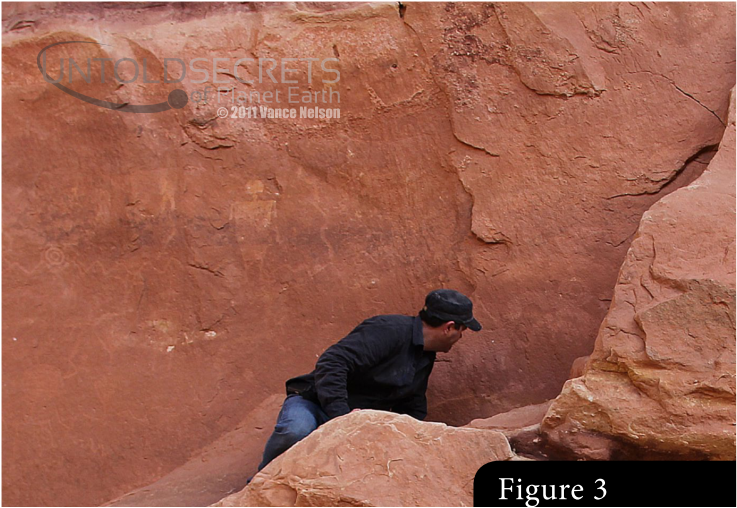 III. The Senter/Cole Conclusions about the Petroglyph:
III. The Senter/Cole Conclusions about the Petroglyph:A. Quoting from their own writing:
“The “head,” “neck,” and “torso” are a single item: a thick, sinuous shape formed by pecking. The “tail” is a second, U- shaped item formed by pecking. That the two items are indeed two separate items is indicated by a gap between them and also by differences in pecking patterns and densities between the two (Figure 1).”
Comments: Here they are suggesting that the petroglyph is really two unrelated and meaningless petroglypths that are not attached. Had Senter and Cole brought a ladder, they would never had made such an embarrassingly false comment. We’re not talking about rocket science here. We’re simply talking about a ladder. It doesn’t need to get delivered to the moon, just Kachina Bridge in Utah. If proper research is to be done, it requires getting up onto the ledge just below the petroglyph itself.
We have examined the petroglyph from literally inches away. The peck marks continue evenly from the body into the tail without a break in the type, depth, erosional features or patination. In other words, their claim that there are two separate petroglypths is patently false (Fig. 4).

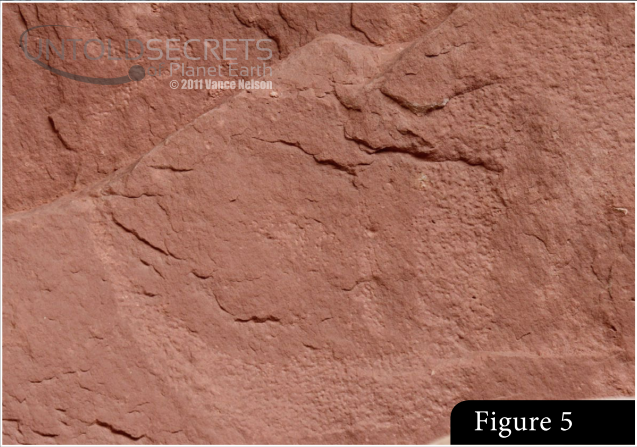
There is no gap as they claim (Fig. 5, close-up). Even their own low resolution, black and white photograph shows this fact. Either they have been inexcusably careless in their research or they have blatantly lied.
B. Quoting from their own writing: “The ‘legs’ are not part of the image and are not pecked or otherwise human-made but are stains of mud or some light-colored mineral on the irregular surface.”
Comments: They suggest that the legs, which have apparently miraculously adhered themselves to the petroglyph, are nothing but a mud or mineral stain. The fact that they say the legs are either “this” or “that” (“stains of mud” or “light-colored mineral”) indicates they are unsure how the legs were produced. It is clear that the legs are lighter in color which is indicative of desert varnish removal. Desert varnish removal can occur in two ways. Water running down from the top can carry abrasives, such as sand, causing desert varnish removal. Since this is clearly not the case here (streaks would be seen from the top of the bridge running down), the only other reasonable possibility is desert varnish was removed by intelligent human means.
It is possible, that originally the legs were partially created via abrasion, a technique of rubbing an area to remove desert varnish. Sometimes petroglyphs are made with both pecking and abrasion. This combination of techniques can be seen on this example from Moab, Utah (Fig. 6). In this example, you can see that the lighter color indicates desert varnish removal. Even though peck marks are resident in the lighter area, they are of fairly low density, just like on the sauropod at Kachina Bridge
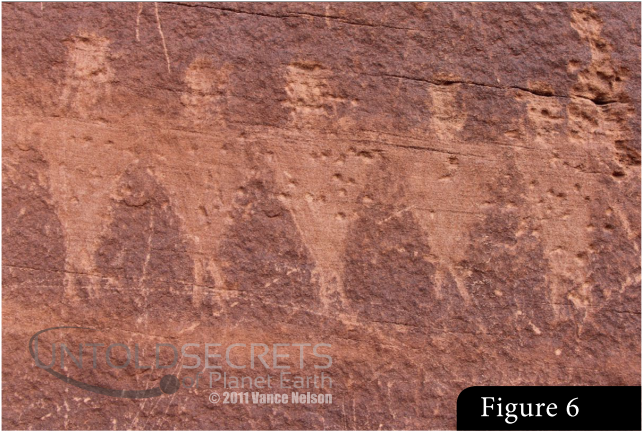
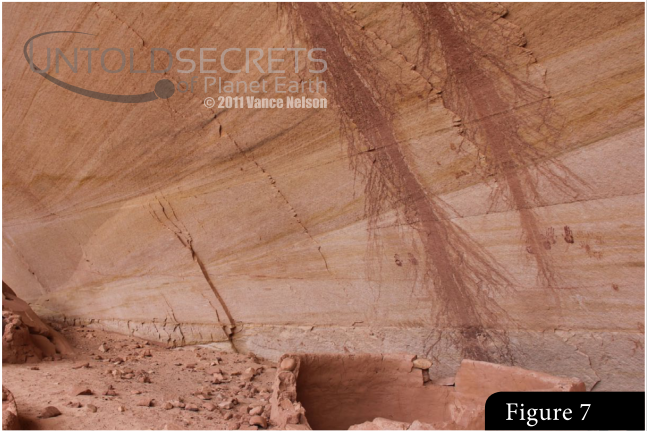

Furthermore, if the legs were mud, from where would this mud have come? How did it form itself into legs and adhere itself to the bottom of the peck marks? The fact is that there are lots of mud deposits, stains if you wish, on Kachina Bridge. Where does the mud come from? It
comes from high up on the bridge and is carried down by water during rains and snow melt. Figure 7 shows the distinct paths mud is carried down the natural bridge.
“...the arguments of Senter and Cole have little to no scientific weight whatsoever.”This article can be read at the below link.
http://evidenceweb.net/pdfs/kachina-bridge.pdf----------------------------------------------------------------------------------------
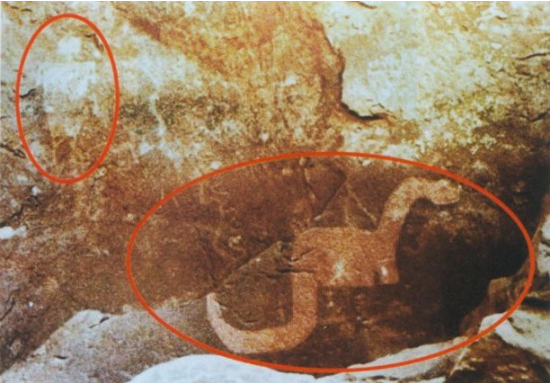 http://www.generalforum.com/science/did ... 94028.html
http://www.generalforum.com/science/did ... 94028.htmlThe above drawing is found in Utah, USA. It was made by American Indians 500 years ago. At the time the Indian people were nomadic tribesmen. That means that they moved around a lot. They were nomads by choice because the hunting of the American Buffalo was their main concern. Well, that and the smoking of the peace pipe. Who can blame them.
The Buffalo never stayed put in just one place. So where ever the Buffalo roamed the Indians followed. They had no cities or high technology and certainly did not have spare scientist digging for bones and collecting the bones where ever they went. Spending the night dancing and singing songs around the camp fire to their gods was the height of their scientific endeavors.
So my question is...
If no one has seen a dinosaur in over 60,000,000 million years, Then just what the hell were they drawing in the cave walls?
There is an image of a man which is certainly definable but what creature even remotely resembles that of a large Horse with a tail the size of a tree and an obvious bump on it's head which we now know that some dinosaurs had atop their heads?
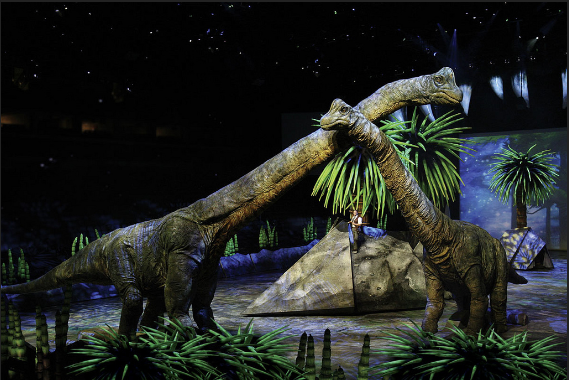
crispybits wrote: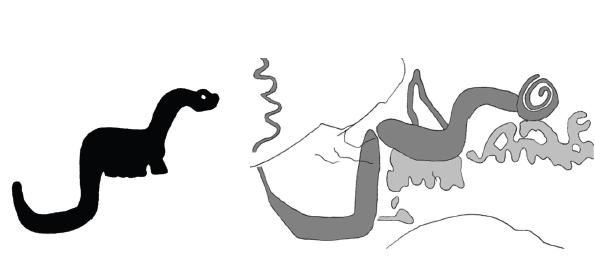
The Kachina Bridge "dinosaur," as drawn by a young earth creationist (left) and as depicted in a line drawing of the petroglyph (right). The dark shading on the line drawing represents carving done by humans, while the light shading represents mud stains that add to the dinosaur illusion. From Senter and Cole, 2011.
About 65.5 million years ago, the last of the non-avian dinosaurs were wiped out in the fallout from one of the earth’s most catastrophic extinction events. They left only bones and traces in the rock behind. Yet there are people who claim that humans actually lived alongside dinosaurs. Young earth creationists have a habit of twisting natural history to fit within the narrow confines of their interpretation of Genesis, and they insist that humans once co-existed with sauropods, tyrannosaurs, ceratopsians and other dinosaurs within the last 6,000 years or so.
To support their fantastical claims, some creationists cite what they believe to be various sculptures, carvings and other artistic representations of dinosaurs made by ancient cultures around the world. Most of these have been discredited as forgeries and misinterpreted objects, but creationists continue to use them as evidence for their peculiar view of earth history. Among the most oft-cited is a petroglyph of what appears to be an Apatosaurus-like sauropod on Kachina Bridge in Utah’s Natural Bridges National Monument. According to the fundamentalist-apologist group Answers in Genesis, “The petroglyph of a sauropod dinosaur clearly has important implications—indicating that dinosaurs were indeed known to men after the Flood until they eventually died out and became (apparently) extinct.” The assumption is that the petroglyph was intentionally carved by humans to represent a single animal that people had actually seen walking around the landscape in the recent past. A paper just published by paleontologists Phil Senter and Sally Cole demolishes this argument.
Have you ever watched the clouds go by and thought you saw one in the shape of an animal, or seen the “man in the moon”? These are examples of pareidolia—seeing what we believe to be a significant shape or pattern when it isn’t really there. This phenomenon also explains the “dinosaur” on Kachina Bridge. Upon close inspection by Senter and Cole, the “sauropod dinosaur” turned out to be made up of distinct carvings and mud stains. It is definitely not a depiction of a single animal, and, viewed in detail, it looks nothing like a dinosaur. The separate carvings and mud stains only look like a dinosaur to those wishing to find one there.
While certainly the most prominent, the supposed sauropod was not the only dinosaur carving creationists thought they saw on the bridge. Three other dinosaur depictions have been said to exist, but Senter and Cole easily debunked these, as well. One of the “dinosaurs” was nothing but a mud stain; a proposed Triceratops was just a composite of petroglyphs that do not represent animals, and what has been described as a carving of Monoclonius was nothing more than an enigmatic squiggle. There are no dinosaur carvings on Kachina Bridge.
The Kachina Bridge petroglyphs were not hoaxes or frauds. They were carved by people who once lived in the region, but there is no indication that any of them represent animals, living or extinct. What creationists thought they saw in the rocks has turned out to be an illusion, but I wonder how many of them will actually admit their mistake?
http://blogs.smithsonianmag.com/dinosau ... na-bridge/Oh and by the way the image you showed is heavily enhanced - here's how it looks without the enhancement:
